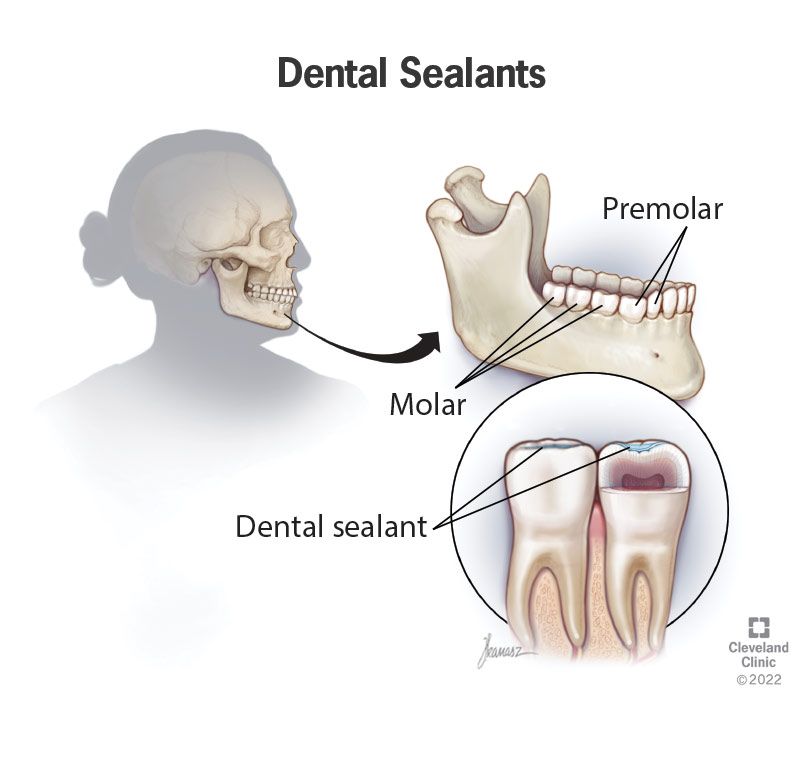Dental sealants are thin, protective coatings that shield the chewing surfaces of your back teeth from harmful, cavity-causing bacteria. Dentists or hygienists may place sealants as part of a preventive dental treatment plan.
Advertisement
Cleveland Clinic is a non-profit academic medical center. Advertising on our site helps support our mission. We do not endorse non-Cleveland Clinic products or services. Policy

Sealants are thin, liquid coatings painted onto the chewing surfaces of your back teeth (premolars and molars). Once applied, a dentist cures and hardens the sealant material to shield and protect your teeth from harmful cavity-causing bacteria.
Advertisement
Cleveland Clinic is a non-profit academic medical center. Advertising on our site helps support our mission. We do not endorse non-Cleveland Clinic products or services. Policy
Manufacturers use a couple different materials to make sealants, including medical-grade:
Dentists place sealants to protect your teeth from disease-causing bacteria. Your back teeth have deep grooves that help you grind up food when you chew. Food and bacteria can become trapped in these grooves, leading to tooth decay (cavities) over time. Sealants coat these areas so bacteria can’t reach them.
Children and teenagers are popular candidates for dental sealants. But adults without decay or dental fillings in their molars can also benefit from this treatment. In general, anyone who’s prone to tooth decay on their back teeth should consider sealants.
Typically, children should get sealants on their permanent molars and premolars as soon as these teeth come in. This way, the dental sealants can protect their teeth through the cavity-prone years (ages 6 through 14).
In some cases, dental sealants may also be appropriate for primary (baby) teeth. For example, if your child has baby teeth with deep depressions and grooves, sealants can protect these areas. Because baby teeth play such an important role in holding space for adult (permanent) teeth, it’s important to keep these teeth healthy so they’re not lost too early.
Advertisement
Sealants are one of the most common preventive dentistry treatments performed today. In the U.S., approximately 42% of children aged 6 to 11 and 48% of adolescents aged 12 to 19 have dental sealants on their adult (permanent) teeth.
There’s nothing you need to do to prepare for dental sealants. Your dentist or hygienist will place them during a routine office visit.
Before they apply the sealants, they’ll thoroughly clean your teeth. This helps prevent bacteria from becoming trapped between the sealant material and your tooth surfaces.
Applying dental sealants is a simple and painless process. It only takes a few minutes for your dentist or hygienist to apply the sealant to each tooth. Your provider will:
While diligent oral hygiene removes plaque, food and debris from your teeth’s smooth surfaces, brushing and flossing can’t always get into all the nooks and crannies. Sealants shield these vulnerable areas from cavities by “sealing out” bacteria, plaque and food particles.
In most cases, the pros of dental sealants outweigh the cons. But here are a few things you should know:
Ask your dentist if sealants are a good preventive option for you.
There’s no downtime after dental sealant placement. You should be able to go back to work or school immediately.
Sealants last up to five years. For best results, you’ll need to have your sealants replaced on a regular basis.
You can resume normal eating and drinking right after your appointment. However, it’s important to know that extremely hard, sticky or chewy foods can chip or erode your new sealants. It’s best to consume these foods in moderation.
You should see your dentist for routine visits at least every six months. During these appointments, your dentist or hygienist will check the health of your teeth and gums and make any treatment recommendations. This is a good time to talk to your dentist about sealants. Ask them if this preventive treatment can help you maintain good oral health.
Advertisement
Additionally, you should schedule an appointment with your dentist any time you notice a change in your oral health. Examples include toothaches, gum pain, bleeding gums, bad breath and other worrisome signs and symptoms.
The short answer is: It depends.
Sealants are a safe and effective way to reduce your or your child’s risk of cavities. Children aged 6 to 11 who don’t have dental sealants are three times more likely to develop tooth decay. In many cases, dental sealants are an excellent investment. They’re less costly than other treatments, and they reduce your chances of needing more invasive dental work in the future.
But sealants aren’t for everyone. People with partially erupted (grown-in) teeth won’t benefit from sealants. Dentists also won’t place sealants on teeth that have fillings or crowns. In these cases, sealants aren’t only unnecessary, but they’re also unhelpful.
To learn more about sealants and whether they’re right for you or your child, talk to your dentist or hygienist.
Dental sealants are a lot like raincoats for your teeth. In the same way a raincoat shields you from the elements, sealants shield your teeth from disease-causing bacteria. Sealants aren’t foolproof, but they can significantly reduce your risk for cavities, giving you the best chance for healthy teeth and gums.
Advertisement
Dentistry plays an important role in oral health. Cleveland Clinic’s experts can design a personalized plan that will keep you smiling for the long haul.

Last reviewed on 03/27/2023.
Learn more about the Health Library and our editorial process.